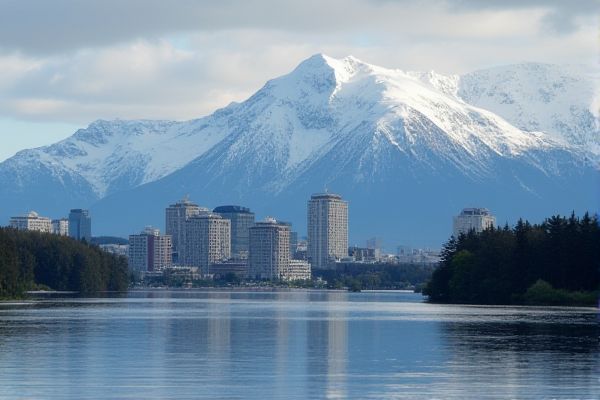
What to know as new resident in Alaska: Extreme weather conditions. Limited daylight in winter. Abundant wildlife encounters. High cost of living. Outdoor activity opportunities. Remote healthcare access. Subsistence lifestyle potential. Unique cultures and traditions. Essential survival skills. Earthquake preparedness.
Extreme weather conditions.
As a new resident in Alaska, be prepared for increasing frequencies of extreme weather events, including heavy snowstorms in Anchorage, deadly landslides in Southeast Alaska, glacial lake outburst floods, and severe coastal storms. Due to declining sea ice and rising sea levels, these events can lead to flooding, infrastructure damage, and other hazards. For more insights, the Alaska Climate Report highlights the critical importance of understanding and addressing these challenges as they become more prevalent.
Limited daylight in winter.
In Alaska, especially in the northern regions, winter brings significantly limited daylight, with some areas experiencing as little as 5-6 hours of sunlight per day. In places like Barrow, there is complete darkness for nearly two months from November to January. To explore more about how this fascinating phenomenon impacts life in Alaska, visit the insights shared by Phantom Salmon Charters, where they delve deeper into the unique characteristics of Alaskan towns enduring these long winter nights.
Abundant wildlife encounters.
As a new resident in Alaska, be prepared for abundant wildlife encounters, including bears, moose, wolves, Dall sheep, and various bird species, often requiring specific tours or visits to places like Denali National Park, Kenai Fjords, and wildlife conservation centers to ensure safe and optimal viewing experiences. For more detailed guidance on making the most of these experiences, be sure to check out this [Alaska Wildlife Advice](https://www.alaska.org/advice/alaska-wildlife). Such tours are integral to understanding and respecting the local ecosystem while enjoying the breathtaking natural beauty that Alaska offers.
High cost of living.
The cost of living in Alaska is significantly higher than the national average, with housing 17% higher, utilities 49% higher, food 36% higher, healthcare 48% higher, and transportation 28% higher. Overall, the cost of living in Alaska is about 30% higher than the national average, making it one of the most expensive states to live in. For more detailed insights into how these expenses compare within the state, visit the Cost of Living Calculator, which offers a comprehensive breakdown of these costs, helping potential residents understand the financial demands of life in Alaska.
Outdoor activity opportunities.
Alaska offers a vast array of outdoor activities, including hiking, fishing, glacier trekking, whale watching, and visiting national parks like Denali, Wrangell-St. Elias, and Glacier Bay. Popular activities also include canoeing, kayaking, and river rafting in numerous lakes and rivers, as well as skiing, snowboarding, and dog sledding in the winter months. For more information on exploring these exhilarating adventures, visit the Things to Do page.
Remote healthcare access.
In Alaska, remote healthcare access is extensively supported through telehealth services, which include video consultations, store-and-forward consultations, and remote patient monitoring. These services, as detailed on the Telehealth Alaska webpage, are covered by Medicaid and private insurers at the same rate as in-person services. Importantly, there are no prior in-person consultation requirements, and these services comply with HIPAA privacy standards.
Subsistence lifestyle potential.
As a new resident in Alaska, it's important to understand that subsistence hunting, fishing, and gathering are crucial for many families and communities, particularly in rural areas, where these activities provide essential nutrition and maintain cultural practices. Subsistence use is protected by both state and federal laws, with the Alaska Legislature and the Alaska National Interest Lands Conservation Act (ANILCA) prioritizing subsistence uses over recreational and commercial activities, although regulations can vary depending on the jurisdiction of the land or waters.
Unique cultures and traditions.
As a new resident in Alaska, you should be aware of the rich and diverse Native cultures, including traditions such as subsistence hunting and foraging, vibrant festivals like the "Celebration" in Juneau, and the significance of storytelling, carving, and weaving in various Alaska Native communities. These traditions highlight the deep connection between the indigenous people and the land, as well as their unique cultural practices and values. To explore these in depth, you can visit Smithsonian Magazine for insightful ways to engage with Alaska Native culture, heritage, and art.
Essential survival skills.
To survive in Alaska, focus on the four main priorities: shelter, water, fire, and food. Utilize natural materials for shelter, secure a water source, build a fire for warmth and signaling, and learn to forage or hunt for food, while also understanding navigation, coping with cold water, and using technology like GPS and satellite phones. For more detailed information on mastering these survival skills, you can explore resources such as the comprehensive guide on surviving in the Alaskan Wilderness provided by the Alaska Wilderness League. These insights can be vital for anyone venturing into the breathtaking yet challenging landscapes of Alaska.
Earthquake preparedness.
To prepare for earthquakes in Alaska, it is crucial to create a family emergency plan and practice the "drop, cover, and hold on" technique. An essential step is to secure your home by fastening heavy items and appliances, and maintain a stockpile of emergency supplies such as flashlights, first aid kits, and non-perishable food. Additionally, ensure you know your tsunami evacuation route and identify safe meeting places for your family. For more comprehensive information, visit the Earthquake Alaska website to learn more about the necessary precautions and preparations.
